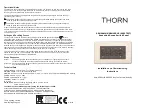
DGS-3312SR Stackable Gigabit Layer 3 Switch
27
Subnet Mask
A Bitmask that determines the extent of the subnet that the Switch is on. Should be of
the form xxx.xxx.xxx.xxx, where each xxx is a number (represented in decimal) between
0
and
255
. The value should be 255.0.0.0 for a Class A network, 255.255.0.0 for a
Class B network, and 255.255.255.0 for a Class C network, but custom subnet masks
are allowed.
Default Gateway
IP address that determines where packets with a destination address outside the
current subnet should be sent. This is usually the address of a router or a host acting as
an IP gateway. If your network is not part of an intranet, or you do not want the Switch
to be accessible outside your local network, you can leave this field unchanged.
VID
This allows the entry of a VLAN ID from which a management station will be allowed to
manage the Switch using TCP/IP (in-band via web manager or Telnet). Management
stations that are on VLANs other than the one entered in the VID field will not be able to
manage the Switch in-band unless their IP addresses are entered in the Security IP
Management menu. If VLANs have not yet been configured for the Switch, the default
VID (1) contains all of the Switch’s ports. There are no entries in the Security IP
Management table, by default
−
so any management station that can connect to the
Switch can access the Switch until either Management Station IP Addresses (see page
28) are assigned or SNMP settings are configured to control management.
Setting the Switch’s IP Address using the Console Interface
Each Switch must be assigned its own IP Address, which is used for communication with an SNMP network
manager or other TCP/IP application (for example BOOTP, TFTP). The Switch’s default IP address is
10.90.90.90. You can change the default Switch IP address to meet the specification of your networking address
scheme.
The IP address for the Switch must be set before it can be managed with the Web-based manager. The Switch IP
address can be automatically set using BOOTP or DHCP protocols, in which case the actual address assigned to
the Switch must be known.
The IP address may be set using the Command Line Interface (CLI) over the console serial port as follows:
Starting at the command line prompt, enter the commands
config ipif System ipaddress
xxx.xxx.xxx.xxx/yyy.yyy.yyy.yyy
. Where the
x
’s represent the IP address to be assigned to the IP interface
named
System
and the
y
’s represent the corresponding subnet mask.
Alternatively, you can enter
config ipif System ipaddress xxx.xxx.xxx.xxx/z
. Where the
x
’s represent the IP
address to be assigned to the IP interface named
System
and the
z
represents the corresponding number of
subnets in CIDR notation.
The IP interface named
System
on the Switch can be assigned an IP address and subnet mask that can then be
used to connect a management station to the Switch’s Telnet or Web-based management agent.
The system message
Success
indicates that the command was executed successfully. The Switch can now be
configured and managed via Telnet and the CLI or via the Web-based management agent using the above IP
address to connect to the Switch.
















































